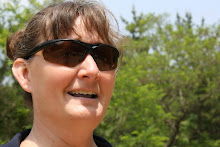Impressions scribbled in my notebook as we are driven from Lagos airport to the compound where the conference is:
The front of the airport is packed with people - standing, wandering, traffic jammed on this two-lane, one-way road as people are picked up and taxi drivers squat, hopeful for a fare. Armed guards (automatic weapons) look scary and I'm not sure who or what they are protecting - the cabbies? the airport security? I am overwhelmed and frightened more than I'd like by the French man's ramblings about the Nigerians being willing to slit my throat just for a pen or no reason at all (though he also - oddly - emphasized how good Nigerians are - such nice people). I am unduly relieved to see two men with a handwritten sign with our names. Our drivers are here.
The road we're on is in excellent condition - paved - but the only traffic signs or signals anywhere are driver's horns. We drive and drive at top speed (100+ kph), merging and flowing like cells in an artery, sometimes 3 or 4 cars across in these 2-3 lanes plus people crowded along the shoulder or walking across the road. I see 3 giant yaks being walked along the highway by a young boy (10 years old?) with a stick. Smog-spitting motorbikes are everywhere, normally with 2 people but sometimes 3; some wear helmets, but these look 20 or 50 years old, often without straps. Autorickshaws, taxis, cars, trucks fill the road and the shoulders. I notice that cross streets are almost all unpaved and deeply rutted. Everything is built of cement, and cement walls surround every building, topped with razor wire or large jagged pieces of embedded glass. I see lots of apartment-style buildings, but nothing is over 4 stories - all the construction looks hand-made, including the thick bamboo scaffolding. No cranes or other large-scale construction equipment anywhere in sight. Most buildings and walls are painted - cream or pastel colors.
People are everywhere - the women are beautifully dressed, immaculate and colorful in mostly traditional dresses and head scarves; men are not as colorful and are less likely to be traditionally dressed. Cell phone towers sprout like weeds.
The 4-lane highway is lined with very wide, red dirt shoulders, on which rest innumerable shacks with rusty tin roofs and walls; here people live and have their businesses. Behind those are cement walls with razor wire, then massive homes that compare to those in many new American suburbs, but much closer together and no intentional landscaping. Between the highway and the shacks are often semi-trucks and piles of garbage; by one market area, with several brightly-colored umbrella stands, an enormous pile of garbage surrounds a burned-out garbage truck.
White cattle egrets - such a lovely plumed bird to see when we camp in the US - walk through the slums and markets, paid no attention by anyone. We pass an enormous walled compound that stretches nearly a mile along the road, with the sign Mountain of Fire and Miracles Church on the cement wall. Our own compound - Redeemer's Camp - is at least as large, including innumerable barn-like structures without walls that serve as auditoriums. We learn later that Redeemer's Camp hosts 2 million worshippers on the first Friday of every month.


